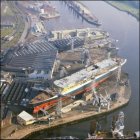John Brown & Company (Clydebank) Ltd
The brothers, James and George Thomson founded the renowned shipbuilding business at Cessnock in 1851. They launched their first ship, the Jackal in 1852 and quickly established a reputation for building prestigious passenger ships.
The company moved in 1871 to the Barns o' Clyde (later re-named Clydebank) near the village of Dalmuir, the location at the confluence of the River Clyde and River Cart, allowed very large ships to be launched. In 1899, John Brown & Company Ltd, a Sheffield steel-maker, took over the yard and by the early 1900s, the company had innovated marine engineering technology with the Brown-Curtis turbine. The performance of these engines impressed the Royal Navy, which placed orders for many of its major warships with the company.
The famous ships built by John Brown’s include, HMS Hood, Tiger, Repulse and Barham, and the Lusitania and Aquitania. The company just survived the post First World war trade depression with orders for Cunard White Star liners - the Queen Mary and Queen Elizabeth. During the Second World War, they – contributed greatly to the war effort, building, amongst others, the battleships, Duke of York and Vanguard and the aircraft carrier, Indefatigable.
Post-war, the large drop in warship orders was balanced by boom in merchant shipbuilding but by the end of the 1950s, the rise of new highly productive shipbuilding nations, made many European yards uncompetitive. At Clydebank, a series of loss-making contracts were taken in the hope of surviving until an upturn in the situation occurred. By the mid 1960s, however, John Brown & Co Ltd, warned that its shipyard was uneconomic and faced potential closure.
The last passenger liner order came from Cunard with “Q4” - Queen Elizabeth 2. Launched as John Brown in September 1967, the QE2 was completed as Upper Clyde Shipbuilders Ltd, the Clydebank yard having merged into the group in February 1968. Upper Clyde Shipbuilders itself collapsed amidst much controversy in 1971. The last true ship to be built at the yard, the bulk grain carrier, Alisa, was completed in 1972. The Clydebank facility continued to operate under various owners until 2001, constructing oil platforms in support of the North Sea oil fields.
With the collapse and liquidation of Upper Clyde Shipbuilders, the records of John Browns and the other Clyde based ship yards that formed that group were in grave danger of being ”lost” forever by neglect, destruction or disposal by sale. The records were viewed by the liquidator as an asset and they were therefore valued and advertised for sale. A deal was brokered whereby the records were secured for the nation by the Keeper of the Records of Scotland in conjunction the City of Glasgow, Clydebank Town Council and Dumbarton County Council. They were acquired by what is now the National Records of Scotland in 1973 on the understanding they would remain permanently in the west of Scotland. The records of John Browns were given to the University of Glasgow to be maintained and preserved. For the full story of this dramatic rescue read Death on the Clyde.
A summary description of the records held by Glasgow University Archive Services can be found in the Upper Clyde Shipbuilders Ltd, Clydebank Division collection.


